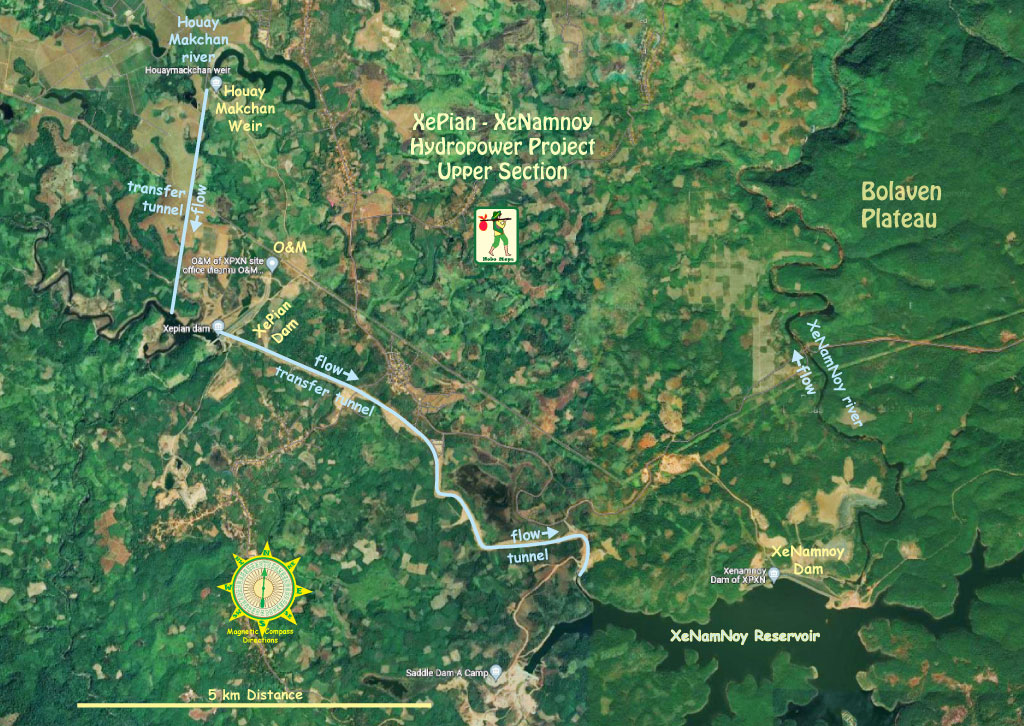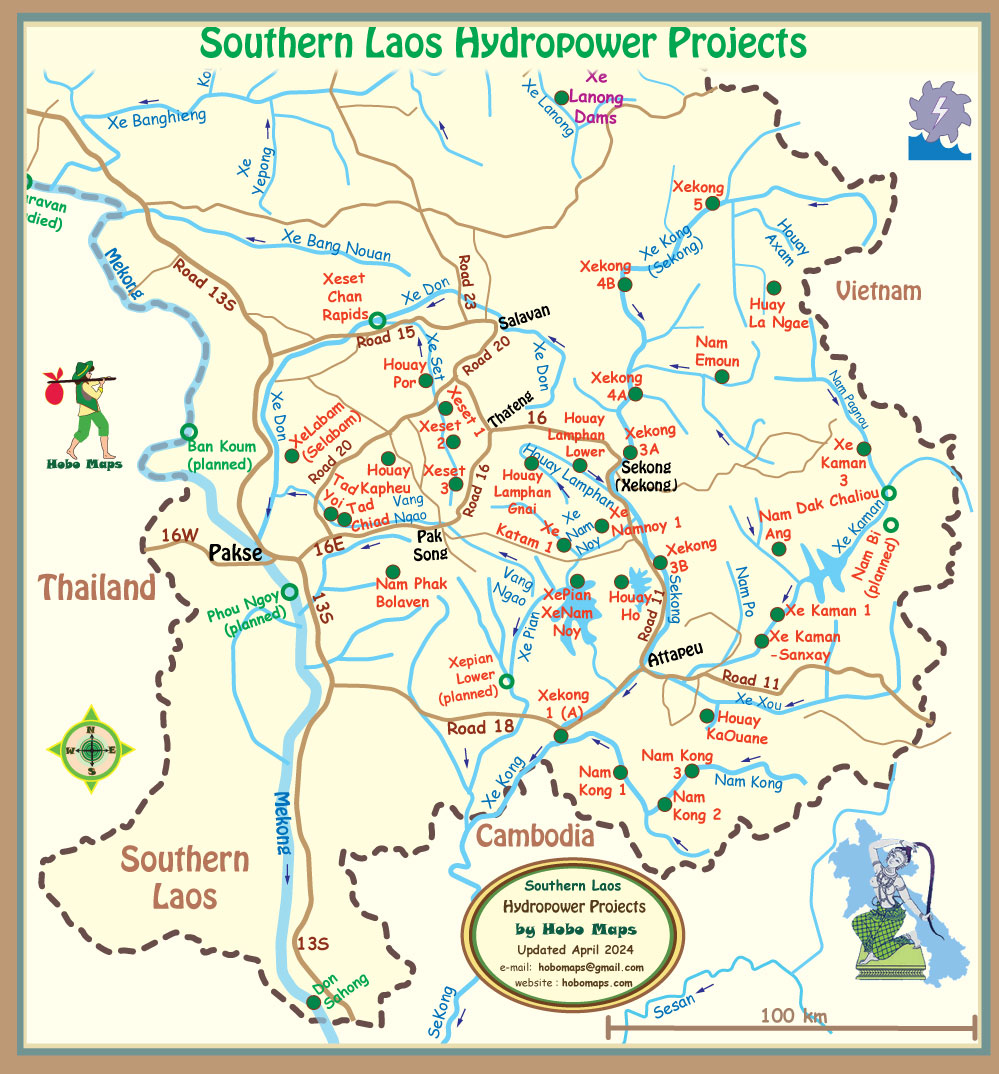
XePian-XeNamnoy Dams Hydropower Info - by Hobo Maps - Go to Hydropower Projects Page - - - Home
Xe Pian-Xe Namnoy Hydropower Project is located on the Bolaven Plateau in Attapeu and Champasak provinces, southern Lao PDR about 80 km east of Pakse. The three main dams are about 35 km northwest of Attapeu town while the powerhouse and tailrace are 5 km west of Attapeu town.
Xe Namnoy Dam below located at coordinates - 15°01'41.9"N 106°36'05.0"E (15.028306, 106.601389) :

Xe Pian Dam below located at coordinates - 15°03'31.2"N 106°31'24.5"E (15.058667, 106.523472) :

The US$ 1.02 billion Xe Pian-Xe Namnoy hydro power project has three main dams Houay Makchan Dam, Xe Pian Dam and Xe Namnoy Dam together with smaller saddle dams. The project has a main storage reservoir on the Xe Namnoy River, underground tunnels, open-channel waterway and a powerhouse.
The power plant started commercial operation on December 6, 2019 and is operated under a 27-year Concession Agreement after which the Project will entirely be transferred to the Government of Laos.
Layout of the Project below.

The upper area of the project with all three of the main dam structures and transfer tunnels is shown in the satellite image below.

The mid area of the project with the pressure tunnel headrace and intake structure at coordinates 14°56'36.2"N 106°37'45.7"E (14.943389, 106.629361) is shown in the satellite image below.

The lower area of the project with the tailrace channel and powerhouse at coordinates 14°50'29.8"N 106°43'56.4"E (14.841611, 106.732333) is shown in the satellite image below.

The project developer Xe-Pian Xe-Namnoy Power Company (PNPC) is a joint venture formed in March 2012 by South Korean-based SK Engineering and Construction ( 24%), Korea Western Power (25%), Ratchaburi Electricity Generating Holding (25%) and Lao Holding State Enterprise (26%).
The project has both debt and equity financing. 30% of the financing came from equity stakes of the project’s four developers while the remaining 70% was secured through a syndicated loan jointly provided by the Export-Import Bank of Thailand and three Thai commercial banks (Ayudhya, Thanachart and the state-owned Krung Thai).

SK Engineering and Construction Co., Ltd. (SKEC) was involved in construction.
Tractebel Engineering was engaged in the construction of the power plant. Excavation of the headrace and other tunnels was completed using a Terratec Tunnel-Boring Machine (TBM) by Right Tunneling.
The main XeNamnoy dam structure is 73 meters high and 1,600 meters long with a reservoir capacityof 1,043 million cubic meters.
The open-air powerhouse is located at the plateau base with a head of more than 630 meters. Water is discharged into a tailrace channel from the powerhouse to the XeKong (river).
The project has three 124 MW Francis turbines and one 38 MW Pelton turbine that together generate 410 MW and up to 1,879 GWh of output per year.
From the 410 MW produced, 370 MW is for export to EGAT under a 27-year power purchase agreement signed in November 2012 and the remaining 40 MW for EDL and domestic consumption in Laos.
Houay Makchanh Weir and pond images below at coordinates - 15°05'28.6"N 106°31'29.2"E (15.091278, 106.524778):


XePian-XeNamnoy Hydropower project location below:

Xe Pian-Xe Namnoy project layout in image below:

The project has a complex system of river flow diversions on the Bolaven Plateau. Water from Houay Makchanh (stream) is impounded and diverted to the Xe Pian reservoir where water from the Xe Pian (river) is also impounded. From there water is channeled to the Xe Namnoy Reservoir which is also fed by the Xe Namnoy (river).
The 74 meter-high Xe Namnoy dam has a reservoir catchment of 522 square km; the 48 meter-high Xe Pian dam has a reservoir catchment area of 217 square km and the 8.5 meter-high Houay Makchan dam has a reservoir catchment of 81 square km.
The 17 km-long waterways from the intake structure to the powerhouse include a headrace tunnel, surge tank, vertical shaft, high pressure tunnel and open steel penstock. A 6 km-long open tailrace channel discharges water from the powerhouse to the Xe Kong river. The project also has five saddle (auxiliary) dams.
XePian-XeNamnoy Hydropower project layout diagrams below:

Xe Pian-Xe Namnoy Hydropower Project details chart below:

XePian Xenamnoy control room image below:

XePian Xenamnoy powerhouse interior image below:

XePian Xenamnoy project headquarters image below:

Xe-Pian Xe-Namnoy powerhouse and switchyard images below:




Xe-Pian Xe-Namnoy intake structure and reservoir image below:

Layout diagram below for the project.

The diversion is made in cascades which start from the Houay Makchan to the Xe-Pian catchment which likewise stores water from the Houay Namliang and then to the Xe-Namnoy Reservoir. One works under free flow from the Houay Makchan to the Xe-Pian Reservoir and the second works under pressurized and free flow conditions from the Xe-Pian Reservoir to the Xe-Namnoy Reservoir,
From the Xe-Namnoy Reservoir, water is conveyed to the powerhouse via a 13.7 km. low pressure headrace concrete lined tunnel, a 550 meter concrete-lined vertical shaft, a 1,300 meter-long steel lined high pressure headrace tunnel and a 750 meter-long penstock.
The project location is shown in central area of map below:

The project is designed to sell electricity annually to the Electricity Generation Authority of Thailand (EGAT) and Electricite du Laos (EDL). Ninety percent of the power generated is exported to Thailand by 500 kV and 230 kV transmission lines. Ten percent goes to the local grid by a 115 kV transmission line.
The 230 kV transmission line export route to Ubon 2 substation in Thailand is shown below as it joins with power exported from Houay Ho HPP.

26 July 2018 disaster - Saddle Dam D collapse and flooded area shown in satellite image below:

A stronger replacement dam for Saddle Dam D has been built and is now constructed with concrete as shown in images below:

Click to see Four short Facebook videos of Xe-Pian Xe-Namnoy project created in 2018.
Video 1 - - Video 2 - - Video 3 - - Video 4
Xe-Pian Xe-Namnoy project History
April 20, 2020: Confirmation of Commercial Operations Date issued by DEB-MEM
March 30, 2020: Certificate of Completion issued by DEM-MEM
January 28, 2020: Certification on the Commercial Operations Date issued by EDL
December 6, 2019: Commercial Operations Date
December 6, 2019: EGAT Certificate of Readiness for Operation for Generator Subsystem: Joint Operation of all Generator Subsystems
December 5, 2019: End of Construction Phase
April 9, 2015: The Xe-Namnoy River is diverted.
February 16, 2015: The Xe-Pian River is diverted.
February 6, 2014: Financial Close with Lenders and Initial Drawdown.
November 28, 2013: Project Financing Documents are signed.
November 28, 2013: Construction Supervision Contract between PNPC and RATCH is signed.
November 15, 2013: Commencement of Construction Phase.
November 15, 2013: Engineering, Purchase and Construction Agreement between PNPC and SK ecoplant is signed.
November 14, 2013: Operations and Maintenance Agreement between PNPC and KOWEPO is signed.
August 22, 2013: Certificates of Fire Prevention and Protection Plan are issued.
May 10, 2013: The PNPC-EDL Power Purchase Agreement is signed.
April 18, 2013: Annex G of the Concession Agreement is signed by the Ministry of Natural Resources and Environment.
March 26, 2013: Certificates for the EIA, EMMP and RMP Report are issued.
March 23, 2013: Concession Registration Certificate is issued.
February 6, 2013 PNPC-EGAT Power Purchase Agreement is signed.
February 1, 2013: Land Lease Agreement is signed between PNPC and the GOL.
December 6, 2012: Tariff MOU with Electricite du Laos between PNPC and EDL is signed.
October 22, 2012: Certificates for the Xe-Pian Dam, Xe-Namnoy Dam, Houay Makchanh Weir, Saddle Dams, Powerhouse and Operator’s Village are signed.
October 19, 2012: Concession Agreement between PNPC and the GOL is signed.
May 2, 2012: Electricity Business Operations License is issued.
April 18, 2012: Official Seal approved.
March 23, 2012 The PNPC is founded by the four major Shareholders.
March 12, 2012: Certificate of Taxpayer Identification is issued.
June 15, 2011: Shareholders’ Agreement is signed by all major Shareholders.
September 29, 2011: Enterprise Name Approval Certificate is issued.
August 16, 2010: Tariff MOU with the Electricity Generating Authority of Thailand is signed.
November 14, 2008: Project Development Agreement between the GOL, SKE&C, RATCH and KOWEPO is signed.
August 6, 2007: Joint Development Agreement between RATCH and SK ecoplant is signed.
August 3, 2006: Project Development MOU between the GOL and initial consortium is signed.
October 23, 2003: MOU between the Korea & Laos Power Development Company and The Government of Laos (GOL) is signed.
July 19, 2005: Project Development MOU between SK ecoplant and KOWEPO is signed.